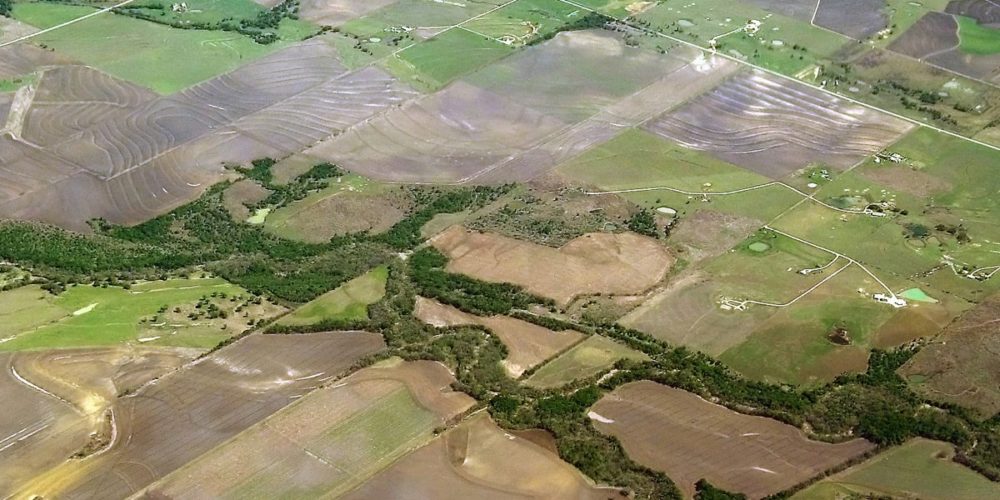Growing up I remember looking forward to Arbor Day as a time when we celebrated planting trees in school, a tradition I came to enjoy in April. As an adult—and as an agricultural scientist interested in how we diversify farms—Arbor Day is an opportune reminder of the benefits that trees and crops have when used together (much more than turning carbon dioxide into oxygen, which was the major selling point I learned as a kid). This has an official name: agroforestry. In the spirit of Arbor Day, I want to celebrate the diverse benefits of agroforestry, and share more about how we might increase trees in agricultural settings.

An illustration of the multiple benefits offered by diverse agroforestry systems. Source: USDA National Agroforestry Center. Illustrator: Gary Bentrup/CC-BY-2.0.
Green infrastructure for agriculture
Green infrastructure is something that we often hear about in the urban context as a way to reduce stormwater and increase green spaces through things like increased permeable surfaces and plant vegetation. Outside of the urban environment, agricultural regions can similarly benefit from using trees as green infrastructure, or more green living cover on farms. Agroforestry itself is not a monolith, but rather the term encompasses a diverse set of crop and tree arrangements offering many environmental benefits, including:

Ginseng grows in the understory of trees, an example of forest farming. Source: USDA National Agroforestry Center
- Windbreaks are rows of trees used primarily to reduce winds and in turn protect people, plants and animals. Windbreaks can increase crop yields, control erosion, lessen snowdrift, shelter pollinators or reduce odors.
- Forest farming is the practice of growing specialty crops under a forest canopy (ginseng and ramps are examples). This requires managing forests to assure that the right amount of shade is provided for understory crops to thrive.
- Riparian forest buffers are intentionally designed regions with trees, shrubs, and/or other perennial plants near rivers, often for water quality and quantity management.
- Alley cropping is mixing crops with trees that can be harvested (nuts, fruits, timber, etc.).
- Silvopasture is the combination of trees and grazing lands. Trees in this setting can provide shelter for livestock, and when properly managed, can benefit the plants growing underneath (they might even be used for additional income, depending on the varieties selected).
Experts suggest that maximizing the benefit of agroforestry is really a matter of finding the right tree for the right purpose, and there are lots of things that trees can help achieve. Agroforestry is known to promote aspects of climate mitigation, through additional carbon stored in trees and soil. It can also promote climate adaptation, including reducing the impacts of heavy rainfall events (by decreasing stormwater runoff through increasing water infiltration and intercepting peak flows). Other benefits of agroforestry include creating corridors for wildlife as well as educational environments to reconnect communities with agricultural production.
Another aspect of agroforestry infrastructure that’s green: dollars! There are many diversified business prospects afforded by agroforestry. In the case of shiitake mushroom cultivation, orchards for beginner farmers, or Native tribes reconnecting indigenous knowledge of diverse agriculture to support local food production, agroforestry can offer opportunities for beginning or underserved farmers to break into agriculture.
Trees might not solve all problems (in fact, trees can be invasive and lead to more problems) so it is important to think first about landowner goals, and then select the most appropriate orientation and species to help achieve them.
How we can help make agroforestry grow
The million-dollar question with environmentally friendly agriculture is why don’t we see more of it? With agroforestry, it’s not just as simple as planting a tree.

Livestock graze on a silvopasture field in Florida. Photo source: USDA National Agroforestry Center, Jim Robinson USDA-NRCS.
Trees require a longer time frame for landowners to plan around compared to crops. So, it’s more complicated than buying seed for one season and harvesting it several months later. A survey of landowners and agricultural professionals in the Southeast found that competing demands (such as for time or finances) with other aspects of crop and livestock operations was a major obstacle to agroforestry. Another hurdle identified was a lack of familiarity with the practice as well as limited demonstration fields. More research could help overcome these obstacles.
At the Union of Concerned Scientists we’re working to increase the public research dollars that go to practices such as agroforestry. For example, our recent analysis found that the overall portion of USDA competitive grant dollars going to projects that including any element of agroecology was less than 15%, with only a tiny fraction of this (less than 1%) going to projects that investigated agroforestry. Small investments in research can support those hoping to generate economic opportunities through practices such as agroforestry, and we will continue to work for a greater portion of the pie for this type of research.
We can call the idea of agroforestry as green infrastructure lots of things: productive conservation, ecobelts or even ecological buffers. Regardless, there’s no getting around the benefits of trees and crops combined. Trees don’t have to be just for ornamentation. They can work for us for in many ways, especially with agriculture.

